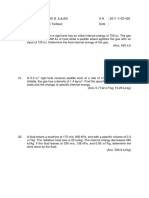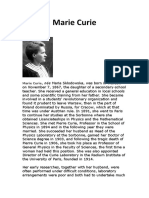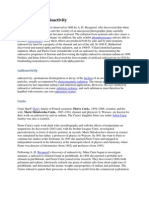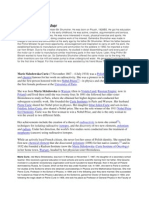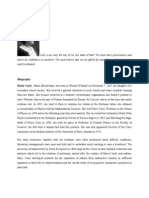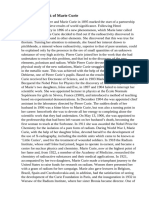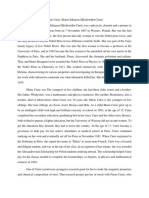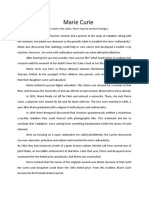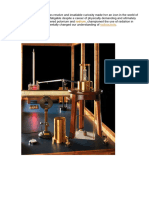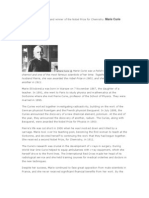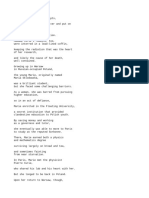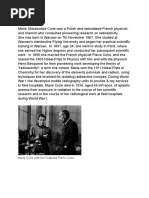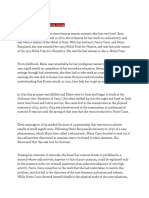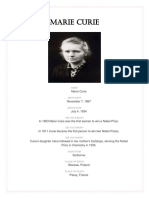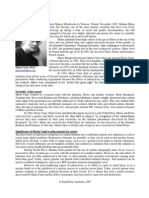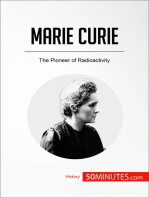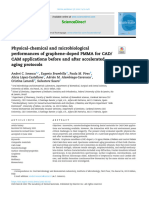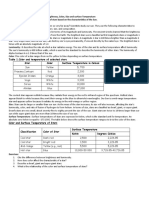Marie Skłodowska Curie (Salomea Skłodowska
Marie Skłodowska Curie (Salomea Skłodowska
Uploaded by
Yin XuanCopyright:
Available Formats
Marie Skłodowska Curie (Salomea Skłodowska
Marie Skłodowska Curie (Salomea Skłodowska
Uploaded by
Yin XuanOriginal Title
Copyright
Available Formats
Share this document
Did you find this document useful?
Is this content inappropriate?
Copyright:
Available Formats
Marie Skłodowska Curie (Salomea Skłodowska
Marie Skłodowska Curie (Salomea Skłodowska
Uploaded by
Yin XuanCopyright:
Available Formats
Marie Curie
(7 Nov 1867 – 4 July 1934)She was born in Warsaw, in what was then the Kingdom of
Poland, part of the Russian Empire. She studied at Warsaw's clandestine Flying
University and began her practical scientific training in Warsaw. In 1891, aged 24, she
followed her older sister Bronisława to study in Paris, where she earned her higher
degrees and conducted her subsequent scientific work. Marie Curie died in 1934, aged
66, at a sanatorium in Sancellemoz (Haute-Savoie), France, of aplastic anemia from
exposure to radiation in the course of her scientific research and in the course of her
radiological work at field hospitals during World War I.[10]
She shared the 1903 Nobel Prize in Physics with her husband Pierre Curie and
physicist Henri Becquerel. She won the 1911 Nobel Prize in Chemistry.
Her achievements included the development of the theory of radioactivity (a term she
coined),[4][5] techniques for isolating radioactive isotopes, and the discovery of two
elements, polonium and radium. Under her direction, the world's first studies were
conducted into the treatment of neoplasms using radioactive isotopes. She founded
the Curie Institutes in Paris and in Warsaw, which remain major centres of medical
research today. During World War I she developed mobile radiography units to
provide X-ray services to field hospitals.
While a French citizen, Marie Skłodowska Curie, who used both surnames,[6][7] never lost
her sense of Polish identity. She taught her daughters the Polish language and took
them on visits to Poland.[8] She named the first chemical element she
discovered polonium, after her native country.[b]
Marie Curie died in 1934, aged 66, at a sanatorium in Sancellemoz (Haute-Savoie),
France, of aplastic anemia from exposure to radiation in the course of her scientific
research and in the course of her radiological work at field hospitals during World War I.
[10]
Marie Skłodowska Curie (/ˈkjʊəri/ KEWR-ee,[3] French: [kyʁi], Polish: [kʲiˈri]; born Maria
Salomea Skłodowska;[a] 7 November 1867 – 4 July 1934) was a Polish and naturalized-
French physicist and chemist who conducted pioneering research on radioactivity. She
was the first woman to win a Nobel Prize, is the only woman to win the Nobel prize
twice, and is the only person to win the Nobel Prize in two different scientific fields. She
was part of the Curie family legacy of five Nobel Prizes. She was also the first woman to
become a professor at the University of Paris, and in 1995 became the first woman to be
entombed on her own merits in the Panthéon in Paris.
Why?
Forme , she is one of th emost inspirable woman in the world, as she doesn’t not scare
Marie Curie, née Sklodowska
The Nobel Prize in Physics 1903
Born: 7 November 1867, Warsaw, Russian Empire (now Poland)
Died: 4 July 1934, Sallanches, France
Prize motivation: "in recognition of the extraordinary services they have rendered by their
joint researches on the radiation phenomena discovered by Professor Henri Becquerel."
Prize share: 1/4
Also awarded: The Nobel Prize in Chemistry 1911
Life
Marie Skłodowska was born in Warsaw, Poland, to a family of teachers who believed
strongly in education. She moved to Paris to continue her studies and there met Pierre
Curie, who became both her husband and colleague in the field of radioactivity. The
couple later shared the 1903 Nobel Prize in Physics. Marie was widowed in 1906, but
continued the couple's work and went on to become the first person ever to be awarded
two Nobel Prizes. During World War I, Curie organized mobile X-ray teams. The Curies'
daughter, Irene, was also jointly awarded the Nobel Prize in Chemistry alongside her
husband, Frederic Joliot.
Work
1903 Prize: The 1896 discovery of radioactivity by Henri Becquerel inspired Marie and
Pierre Curie to further investigate this phenomenon. They examined many substances
and minerals for signs of radioactivity. They found that the mineral pitchblende was more
radioactive than uranium and concluded that it must contain other radioactive
substances. From it they managed to extract two previously unknown elements,
polonium and radium, both more radioactive than uranium.
1911 Prize: After Marie and Pierre Curie first discovered the radioactive elements
polonium and radium, Marie continued to investigate their properties. In 1910 she
successfully produced radium as a pure metal, which proved the new element's
existence beyond a doubt. She also documented the properties of the radioactive
elements and their compounds. Radioactive compounds became important as sources
of radiation in both scientific experiments and in the field of medicine, where they are
used to treat tumors.
arie Curie, née Maria Sklodowska, was born in Warsaw on November 7, 1867, the
daughter of a secondary-school teacher. She received a general education in local
schools and some scientific training from her father. She became involved in a students’
revolutionary organization and found it prudent to leave Warsaw, then in the part of
Poland dominated by Russia, for Cracow, which at that time was under Austrian rule. In
1891, she went to Paris to continue her studies at the Sorbonne where she obtained
Licenciateships in Physics and the Mathematical Sciences. She met Pierre Curie,
Professor in the School of Physics in 1894 and in the following year they were married.
She succeeded her husband as Head of the Physics Laboratory at the Sorbonne, gained
her Doctor of Science degree in 1903, and following the tragic death of Pierre Curie in
1906, she took his place as Professor of General Physics in the Faculty of Sciences, the
first time a woman had held this position. She was also appointed Director of the Curie
Laboratory in the Radium Institute of the University of Paris, founded in 1914.
Her early researches, together with her husband, were often performed under difficult
conditions, laboratory arrangements were poor and both had to undertake much
teaching to earn a livelihood. The discovery of radioactivity by Henri Becquerel in 1896
inspired the Curies in their brilliant researches and analyses which led to the isolation of
polonium, named after the country of Marie’s birth, and radium. Mme. Curie developed
methods for the separation of radium from radioactive residues in sufficient quantities to
allow for its characterization and the careful study of its properties, therapeutic properties
in particular.
Mme. Curie throughout her life actively promoted the use of radium to alleviate suffering
and during World War I, assisted by her daughter, Irene, she personally devoted herself
to this remedial work. She retained her enthusiasm for science throughout her life and
did much to establish a radioactivity laboratory in her native city – in 1929 President
Hoover of the United States presented her with a gift of $ 50,000, donated by American
friends of science, to purchase radium for use in the laboratory in Warsaw.
Mme. Curie, quiet, dignified and unassuming, was held in high esteem and admiration
by scientists throughout the world. She was a member of the Conseil du Physique
Solvay from 1911 until her death and since 1922 she had been a member of the
Committee of Intellectual Co-operation of the League of Nations. Her work is recorded in
numerous papers in scientific journals and she is the author of Recherches sur les
Substances Radioactives (1904), L’Isotopie et les Éléments Isotopes and the
classic Traité’ de Radioactivité (1910).
The importance of Mme. Curie’s work is reflected in the numerous awards bestowed on
her. She received many honorary science, medicine and law degrees and honorary
memberships of learned societies throughout the world. Together with her husband, she
was awarded half of the Nobel Prize for Physics in 1903, for their study into the
spontaneous radiation discovered by Becquerel, who was awarded the other half of the
Prize. In 1911 she received a second Nobel Prize, this time in Chemistry, in recognition
of her work in radioactivity. She also received, jointly with her husband, the Davy Medal
of the Royal Society in 1903 and, in 1921, President Harding of the United States, on
behalf of the women of America, presented her with one gram of radium in recognition of
her service to science.
For further details, cf. Biography of Pierre Curie. Mme. Curie died in Savoy, France, after
a short illness, on July 4, 1934.
You might also like
- ch12 Ques 2013Document47 pagesch12 Ques 2013VictoriaMcKaba90% (10)
- 30 37Document13 pages30 37Danerys TargaryanNo ratings yet
- Marie SklodowskaDocument3 pagesMarie SklodowskaMa Michelle Nica DmNo ratings yet
- Marie CurieDocument3 pagesMarie Curiemay ehabNo ratings yet
- Discovery of RadioactivityDocument6 pagesDiscovery of RadioactivityJariza Daryl Tamang MejiaNo ratings yet
- Marie Curie Biography: SynopsisDocument4 pagesMarie Curie Biography: SynopsisVan Ly100% (1)
- Marie CurieDocument6 pagesMarie CurieAhmed Abd allaNo ratings yet
- Marie Curie 1+2Document3 pagesMarie Curie 1+217decc07No ratings yet
- Marie Skłodowska Curie (Skłodowska : French: PolishDocument1 pageMarie Skłodowska Curie (Skłodowska : French: PolishAna KowalskaNo ratings yet
- Critical Thinking Unit 6Document5 pagesCritical Thinking Unit 6leongeladoNo ratings yet
- Marie Curie AnglaisDocument3 pagesMarie Curie Anglaisseb.lamarre4748No ratings yet
- Practice - Prove That This Is A Written TextDocument3 pagesPractice - Prove That This Is A Written TextVincent Anh TuấnNo ratings yet
- IELTS Academic Reading 03 PDFDocument5 pagesIELTS Academic Reading 03 PDFThanh LiêmNo ratings yet
- Gehendra ShumsherDocument2 pagesGehendra ShumsherAmir MaharjanNo ratings yet
- Marie Curie BiographyDocument5 pagesMarie Curie BiographyRenjie OliverosNo ratings yet
- Ec 38015 1286555348Document2 pagesEc 38015 1286555348alexandra_6No ratings yet
- Untitled DocumentDocument3 pagesUntitled DocumenttatenlagcdNo ratings yet
- Who Is She?: Marie Was A Famous Physician For Her Work On Radioactivity and She Won The Nobel Prize TwiceDocument11 pagesWho Is She?: Marie Was A Famous Physician For Her Work On Radioactivity and She Won The Nobel Prize TwiceLiss ValderramaNo ratings yet
- Early Life: Born: Died: Nationality: Famous For: AwardsDocument2 pagesEarly Life: Born: Died: Nationality: Famous For: AwardsNur Ayunni KhafizNo ratings yet
- Reading 2Document2 pagesReading 2Asemai0099No ratings yet
- Marie CurieDocument3 pagesMarie CurieAriva JasmineNo ratings yet
- Who Was Marie CurieDocument3 pagesWho Was Marie CurieDenisa DamianNo ratings yet
- Marie CurieDocument5 pagesMarie Curiei wyn jati adnyanaNo ratings yet
- Madame CurieDocument5 pagesMadame CurieВладиславМартьяновNo ratings yet
- Madame CurieDocument3 pagesMadame CurieUjwala GangaNo ratings yet
- Marie Curie: Early LifeDocument2 pagesMarie Curie: Early LifeKalaivani JsNo ratings yet
- Marie Curie I Was Born in France The 7 November 1867 and I Died 4 July 1934Document1 pageMarie Curie I Was Born in France The 7 November 1867 and I Died 4 July 1934Rosales SandyNo ratings yet
- The Life and Work of Marie CurieDocument4 pagesThe Life and Work of Marie Curiehieuccc20No ratings yet
- Marie Salomea SkłodowskaDocument1 pageMarie Salomea Skłodowskaappy builderNo ratings yet
- Script & Summary of Marie CurieDocument2 pagesScript & Summary of Marie CurieGrace Victoria Poo 1428041No ratings yet
- Marie CurieDocument1 pageMarie CurieAnvi bNo ratings yet
- Marie Curie 1867-1934Document42 pagesMarie Curie 1867-1934zmeugaby89No ratings yet
- Marie CurieDocument2 pagesMarie CurieBhaskarNo ratings yet
- The First Woman Who Won Nobel PrizeDocument4 pagesThe First Woman Who Won Nobel PrizeThwin Htut AungNo ratings yet
- The Genius of Marie Curie Shohini GhoseDocument4 pagesThe Genius of Marie Curie Shohini GhoseMarta HrynyovskaNo ratings yet
- Presentation - Marie CurieDocument3 pagesPresentation - Marie CurieGiovanni MontàNo ratings yet
- Writing Task Marie CurieDocument1 pageWriting Task Marie CurieleongeladoNo ratings yet
- MozillaDocument25 pagesMozillaSiddharth RajamohananNo ratings yet
- Marija KiriDocument5 pagesMarija KiriemirNo ratings yet
- Marie Curie - 20241004 - 172636 - 0000Document1 pageMarie Curie - 20241004 - 172636 - 0000jazmincitaromero28No ratings yet
- Marie CurieDocument6 pagesMarie Curieapi-242267718No ratings yet
- Marie Curie With Her Husband Pierre CurieDocument1 pageMarie Curie With Her Husband Pierre CurielivNo ratings yet
- Marie CurieDocument12 pagesMarie CurieDivya PriyaNo ratings yet
- Marie CurieDocument18 pagesMarie CurieANS Filologia Biznes i ZarządzanieNo ratings yet
- Marie Curie Group-08Document5 pagesMarie Curie Group-08Bahesty Monfared AkashNo ratings yet
- Marie Curie by Morgan and OisinDocument7 pagesMarie Curie by Morgan and OisinMrGilmartinNo ratings yet
- Maria SkłodowskaCurieDocument4 pagesMaria SkłodowskaCurieswiderskalenkaNo ratings yet
- PB Sample Academic Reading Note Completion Task and KeyDocument4 pagesPB Sample Academic Reading Note Completion Task and KeyЕлена СурмиловаNo ratings yet
- Marie Salomea SkłodowskaDocument1 pageMarie Salomea SkłodowskaChatta NeeladeviNo ratings yet
- The Life & Work of Marie Curie: Reading Passage - 1Document11 pagesThe Life & Work of Marie Curie: Reading Passage - 1Harsh ShethNo ratings yet
- Marie CurieDocument4 pagesMarie CurieCherrisNo ratings yet
- Marie CurieDocument9 pagesMarie CurieGeorgiana LunguNo ratings yet
- Science Hall of Fame Final DraftDocument1 pageScience Hall of Fame Final Draftapi-551111629No ratings yet
- MarieCurie ResearchWork Chemistry Igcse L1Document5 pagesMarieCurie ResearchWork Chemistry Igcse L1rawaljaydityaNo ratings yet
- Radioactivas", Trabajo Que Le Valió El Grado de Doctor Con Mención Cum Laude y El PremioDocument2 pagesRadioactivas", Trabajo Que Le Valió El Grado de Doctor Con Mención Cum Laude y El PremioZachary RiceNo ratings yet
- Biography of Marie CurieDocument2 pagesBiography of Marie CurieSarah Don100% (1)
- Marie Curie: Navigation SearchDocument3 pagesMarie Curie: Navigation SearchSarvesh JaiswalNo ratings yet
- Marie Curie Was Born in Warsaw On November 7, 1867. Her Mother Was ADocument2 pagesMarie Curie Was Born in Warsaw On November 7, 1867. Her Mother Was AJames LambNo ratings yet
- Marie Curie - BiographyDocument1 pageMarie Curie - BiographyFlores Velázquez MarianaNo ratings yet
- Referat Marie CurieDocument4 pagesReferat Marie CurieCatalina GraureNo ratings yet
- Marie Curie ProjectDocument2 pagesMarie Curie ProjectMateiPaulNo ratings yet
- GT Section ReportDocument40 pagesGT Section ReportAnesu ChimhowaNo ratings yet
- 1 s2.0 S0109564122001944 MainDocument12 pages1 s2.0 S0109564122001944 MainDANTE DELEGUERYNo ratings yet
- Structure and Di Ffusion Behavior of Trioctyl Trimellitate (TOTM) in PVC Film Studied by ATR-IR SpectrosDocument11 pagesStructure and Di Ffusion Behavior of Trioctyl Trimellitate (TOTM) in PVC Film Studied by ATR-IR SpectrosGanciarov MihaelaNo ratings yet
- GravityAndOrbits StudentActivityDocument11 pagesGravityAndOrbits StudentActivityPatricia LópezNo ratings yet
- Alcohol Determination (USP 40)Document2 pagesAlcohol Determination (USP 40)lisaNo ratings yet
- Ix Metal SubDocument4 pagesIx Metal SubRenan Lucena da CruzNo ratings yet
- 2006 Chemistry - James Ruse With SolutionsDocument44 pages2006 Chemistry - James Ruse With SolutionsYuki SuzukiNo ratings yet
- Chapter 1 Chemical FoundationsDocument8 pagesChapter 1 Chemical FoundationsKevin HuangNo ratings yet
- Applied Solid State Physics: Introduction ToDocument423 pagesApplied Solid State Physics: Introduction ToAlejandro PuceiroNo ratings yet
- Abhishek GuptaDocument5 pagesAbhishek GuptaAbhishek KumarNo ratings yet
- Structure and Functions of Biological Molecules: at The End of The Lesson, You Are Expected ToDocument4 pagesStructure and Functions of Biological Molecules: at The End of The Lesson, You Are Expected ToFrancinne MartinNo ratings yet
- Basu - 2010 - Journal of Food Engineering PDFDocument9 pagesBasu - 2010 - Journal of Food Engineering PDFMartha Liliana Bedoya AndocillaNo ratings yet
- Newtown's Law of MotionDocument3 pagesNewtown's Law of MotionSaly Zydny Almasco PalenciaNo ratings yet
- Automated Weld Overlay For Corrosion Protection Towers New BrochureDocument8 pagesAutomated Weld Overlay For Corrosion Protection Towers New Brochurevenkatraman ramanathanNo ratings yet
- Msds-Methyl Orange IndicatorDocument7 pagesMsds-Methyl Orange IndicatorHayleyNo ratings yet
- Science 9 Quarter 3 Act9Document2 pagesScience 9 Quarter 3 Act9Catherine Faith VillaruzNo ratings yet
- Physical Sciences Grade 11 June P2 Marking Guidline - 2Document2 pagesPhysical Sciences Grade 11 June P2 Marking Guidline - 2PhilNo ratings yet
- What Is NaphthaDocument7 pagesWhat Is Naphthamsabah bugtigNo ratings yet
- CAPE Papers SortedDocument4 pagesCAPE Papers SortedShanieza AliNo ratings yet
- Topic Questions DensityDocument11 pagesTopic Questions DensityJoe Y. MathewNo ratings yet
- Insulating Heat ProjectDocument4 pagesInsulating Heat ProjectadeladelgreenNo ratings yet
- WercsDocument10 pagesWercsFatima Ezzohra SafsafaNo ratings yet
- High Purity Excipients GuideDocument8 pagesHigh Purity Excipients GuideSA100% (1)
- Glass Fractures and FragmentsDocument6 pagesGlass Fractures and Fragments李姍姍No ratings yet
- CIE IGCSE Science.Document2 pagesCIE IGCSE Science.Mais MarwanNo ratings yet
- Brochure Metallurgical Testing LabDocument4 pagesBrochure Metallurgical Testing LabShravankumar PawarNo ratings yet
- Physics 30 DecDocument8 pagesPhysics 30 DecHARSH KUMAR SINGHNo ratings yet
- Electrostatic Formula RevisionDocument5 pagesElectrostatic Formula RevisionSuyash GuptaNo ratings yet

